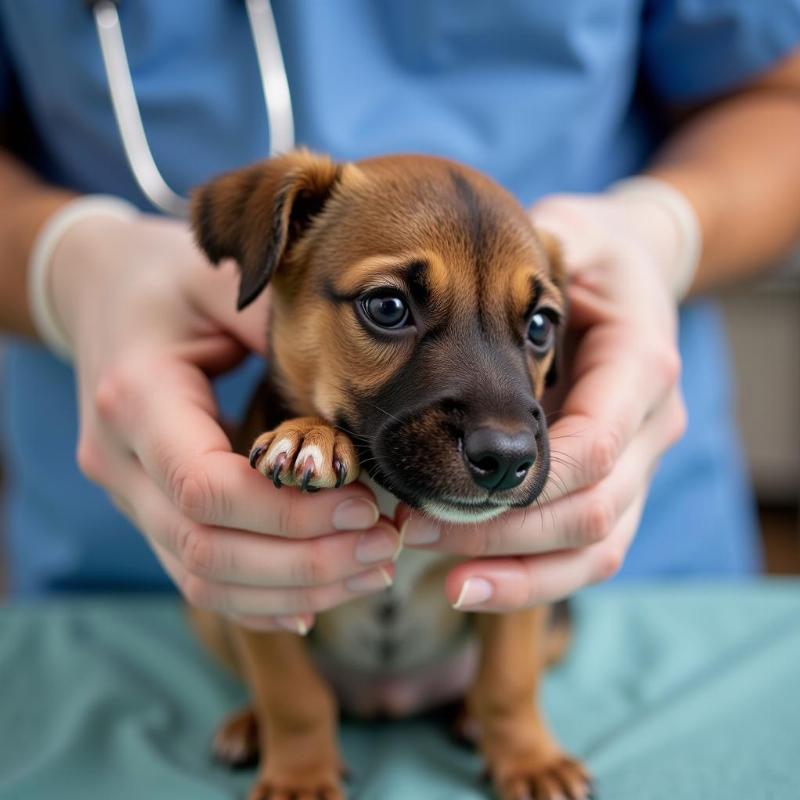Back dew claws, those extra digits higher up on a dog’s leg, are a fascinating and sometimes confusing topic for dog owners. Understanding their purpose, potential issues, and breed-specific prevalence is key to providing the best care for your furry friend. This article delves into everything you need to know about dog breeds with back dew claws.
Many dog owners wonder about the function and necessity of these extra toes. Are they vestigial remnants of a bygone era, or do they serve a purpose in the modern dog? Some breeds commonly have back dew claws while others rarely do. Knowing which breeds are predisposed can help you anticipate potential health concerns and understand the unique needs of these breeds.
Why Do Some Dogs Have Back Dew Claws?
Back dew claws are considered a primitive trait, a throwback to earlier canine ancestors. While front dew claws often aid in gripping and maneuvering objects, back dew claws generally have less functionality. In some breeds, however, they can provide extra stability, particularly on uneven terrain or when climbing. They may also assist in turning and quick movements.
Are Back Dew Claws a Problem?
While often harmless, back dew claws can sometimes pose health risks. They are prone to snagging and tearing, leading to painful injuries and potential infections. If a dog’s back dew claw is loosely attached, it’s more susceptible to these injuries.
Which Dog Breeds Commonly Have Back Dew Claws?
Certain breeds are more likely to have back dew claws, often dictated by breed standards established by organizations like the American Kennel Club. These standards often reflect the historical working roles of these breeds.
- Beauceron: This French herding breed often boasts double back dew claws, adding to their distinctive appearance and potentially aiding in their agile movements while herding livestock.
- Briard: Another French herding breed, the Briard, is also known for its double back dew claws. These extra digits are considered a breed standard and are thought to contribute to their surefootedness.
- Great Pyrenees: Developed to protect livestock in mountainous regions, the Great Pyrenees often has single or double back dew claws, which likely provide extra traction and stability in challenging terrain.
- Norwegian Lundehund: This unique breed was originally bred to hunt puffins along steep cliffs. Their multiple dew claws on each paw, including back dew claws, are believed to have provided exceptional grip and climbing ability.
Many other breeds can occasionally exhibit back dew claws, even if it’s not a breed standard. These include breeds like the Saint Bernard, Anatolian Shepherd, and Australian Shepherd. what-dog-breeds-have-rear-dew-claws
What if My Dog’s Back Dew Claw Gets Injured?
If your dog injures a back dew claw, it’s crucial to seek veterinary care promptly. The vet can assess the damage, clean the wound, and potentially remove the claw if necessary.
Should Back Dew Claws Be Removed?
Removal of back dew claws is a common practice, often performed on puppies within the first few days of life. dog-slipping-on-wood-floor While considered relatively simple, it’s a surgical procedure and should only be performed by a qualified veterinarian.  Puppy Dew Claw Removal
Puppy Dew Claw Removal
Are There Risks Associated with Dew Claw Removal?
While generally safe, dew claw removal carries potential risks like bleeding, infection, and nerve damage. Discussing these risks with your veterinarian is essential to making an informed decision. dogs-dew-claw-hanging-off
Living with a Dog with Back Dew Claws
If your dog has back dew claws, regular inspection and care are essential. Keep the nails trimmed to prevent overgrowth and snagging. Check the claws regularly for any signs of injury or infection. small-dog-breeds-with-back-dew-claws my-dog-back-legs-not-working
Conclusion
Back dew claws are a fascinating aspect of canine anatomy. Understanding their purpose, potential problems, and prevalence in different breeds is crucial for responsible dog ownership. Regular care and attention to these extra digits can help ensure your furry friend’s overall health and well-being. Remember to consult with your veterinarian for any concerns or questions about your dog’s back dew claws.
FAQ
- Do all dogs have back dew claws? No, not all dogs have back dew claws. Their presence varies by breed.
- Are double back dew claws common? Double back dew claws are less common than single back dew claws and are typically found in specific breeds.
- When should back dew claws be removed? Removal is typically done within the first few days of a puppy’s life.
- Is dew claw removal painful? While performed under anesthesia in puppies, there can be some discomfort during recovery.
- What are the signs of an infected dew claw? Signs include swelling, redness, discharge, and limping.
- Can back dew claws be removed in adult dogs? Yes, but it’s a more complex procedure than in puppies.
- Are there any benefits to keeping back dew claws? In some breeds, they can offer extra stability and traction.
Beautdogs.us is your premier online destination for all things dog-related in the US. We offer expert advice on dog breeds, care, and products, catering to both new and experienced dog owners. From breed-specific information to grooming tips and product reviews, Beautdogs.us is your trusted resource. Connect with us for personalized guidance: Email: [email protected], Phone: +1 501-555-7529.